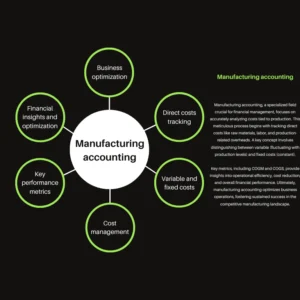Cost of goods manufactured
Cost of Goods Manufactured (COGM) is a fundamental concept in manufacturing accounting and financial management that plays a crucial role in determining a company’s profitability and efficiency in its production process. It refers to the total production costs incurred by a company during a specific accounting period, including direct materials, direct labor, and manufacturing overhead.
Understanding COGM is vital for businesses as it helps in evaluating the efficiency of their production operations and identifying areas for cost optimization. By analyzing the COGM, businesses can make informed decisions on pricing strategies, inventory management, and overall cost control, enabling them to stay competitive in the market.
Cost of goods manufactured formula
The Cost of Goods Manufactured (COGM) can be calculated using the following formula:
COGM = Opening Work-in-Progress Inventory + Total Manufacturing Costs Incurred – Closing Work-in-Progress Inventory
To illustrate this, let’s consider an example of a fictional manufacturing company, XYZ Inc. At the beginning of the year, XYZ Inc. had $50,000 worth of work-in-progress inventory. During the year, they incurred $300,000 indirect materials, $200,000 in direct labor, and $150,000 in manufacturing overhead. At the end of the year, the closing work-in-progress inventory was valued at $40,000.
Using the COGM formula, we can calculate the cost of goods manufactured as follows:
COGM = $50,000 + ($300,000 + $200,000 + $150,000) – $40,000
COGM = $50,000 + $650,000 – $40,000
COGM = $660,000
Therefore, the Cost of Goods Manufactured for XYZ Inc. during the year amounts to $660,000. This figure represents the total cost of the goods produced and ready for sale during that period.
Schedule of cost of goods manufactured
A Schedule of Cost of Goods Manufactured is a financial statement that provides a detailed breakdown of the various costs incurred during the manufacturing process of a company’s products. It outlines the direct materials, direct labor, and manufacturing overhead costs, as well as the changes in work-in-progress inventory throughout the accounting period.
The purpose of this schedule is to help management and stakeholders understand the total cost involved in producing the goods available for sale.
Please see the example below.
| Cost Component | Amount $ |
| Total Direct Materials Used | $95,000 |
| Direct Labor | $60,000 |
| Manufacturing Overhead | $45,000 |
| Total Manufacturing Costs | $200,000 |
| Beginning WIP Inventory | $10,000 |
| Total Manufacturing Costs | $200,000 |
| Ending WIP Inventory | $15,000 |
| Cost of Goods Manufactured | $195,000 |
How to calculate the cost of goods manufactured
Calculating the Cost of Goods Manufactured (COGM) involves summing up all the costs incurred during the manufacturing process to produce goods available for sale during a specific accounting period. To calculate COGM, begin with the total direct materials cost, which includes both the beginning raw materials inventory and purchases minus the ending raw materials inventory.

Next, add the total direct labor costs and the total manufacturing overhead costs. This sum represents the total manufacturing costs. Then, consider the change in work-in-progress inventory, which includes both the beginning and ending work-in-progress inventory values. Finally, subtract the change in work-in-progress inventory from the total manufacturing costs.
The resulting figure is the Cost of Goods Manufactured, providing crucial insights into a company’s production expenses and assisting in pricing decisions and performance evaluations.
Statement of cost of goods manufactured
The Statement of Cost of Goods Manufactured (COGM) is a financial statement that presents a comprehensive breakdown of the total manufacturing costs incurred during a specific accounting period. It includes direct materials, direct labor, and manufacturing overhead costs.
The statement starts with the beginning inventory of work-in-progress, adds the total manufacturing costs, and deducts the ending work-in-progress inventory to arrive at the COGM figure. The COGM is essential for businesses to evaluate production efficiency, control costs, and determine the overall value of goods manufactured and ready for sale.
This statement plays a crucial role in the financial reporting and decision-making processes of manufacturing companies.
| Cost Component | Amount |
|---|---|
| Beginning Raw Materials Inv. | $30,000 |
| Purchases of Raw Materials | $100,000 |
| Ending Raw Materials Inv. | ($25,000) |
| Total Direct Materials Used | $105,000 |
| Direct Labor | $80,000 |
| Manufacturing Overhead | $50,000 |
| Total Manufacturing Costs | $235,000 |
| Beginning WIP Inventory | $20,000 |
| Total Manufacturing Costs | $235,000 |
| Ending WIP Inventory | ($25,000) |
| Cost of Goods Manufactured | $230,000 |
Cost of goods manufactured with example
Let’s consider a practical example of calculating the Cost of Goods Manufactured (COGM) for a fictional company, ABC Electronics, during September 2023.
- Direct Materials:
- Beginning Raw Materials Inventory: $50,000
- Purchases of Raw Materials: $200,000
- Ending Raw Materials Inventory: $60,000
- Total Direct Materials Used: $190,000 (Calculation: $50,000 + $200,000 – $60,000)
- Direct Labor:
- Total Direct Labor Costs: $120,000
- Manufacturing Overhead:
- Total Manufacturing Overhead Costs: $80,000
Total Manufacturing Costs:
The sum of Direct Materials, Direct Labor, and Manufacturing Overhead: $390,000 (Calculation: $190,000 + $120,000 + $80,000)
Therefore, the Cost of Goods Manufactured for ABC Electronics amounts to $390,000. This figure represents the total cost incurred in the production process for goods that are now ready to be sold or moved to the finished goods inventory. COGM is a critical financial metric for businesses, aiding in pricing decisions, evaluating operational efficiency, and determining overall profitability.





[…] Cost of Goods Manufactured (COGM) […]
[…] accounting relies on key performance metrics, including the cost of goods manufactured (COGM) and the cost of goods sold (COGS). These metrics serve as valuable tools for assessing […]
Your article helped me a lot, is there any more related content? Thanks!